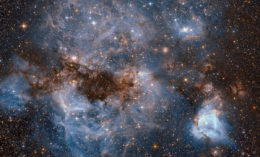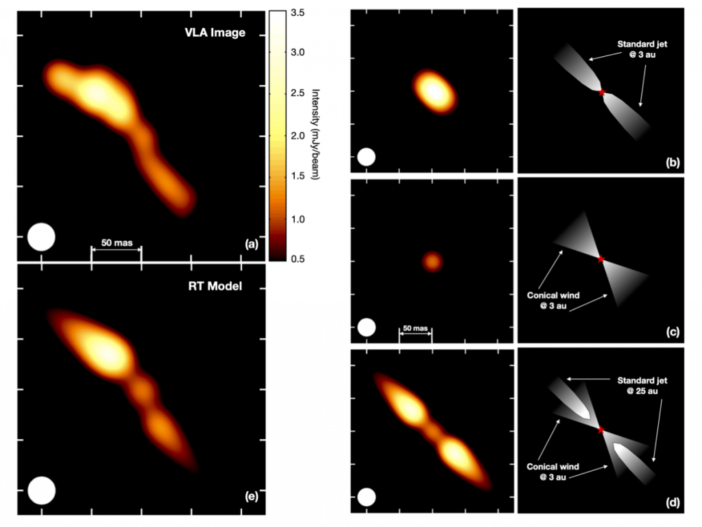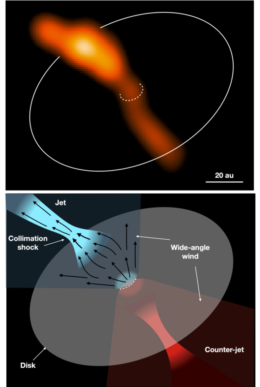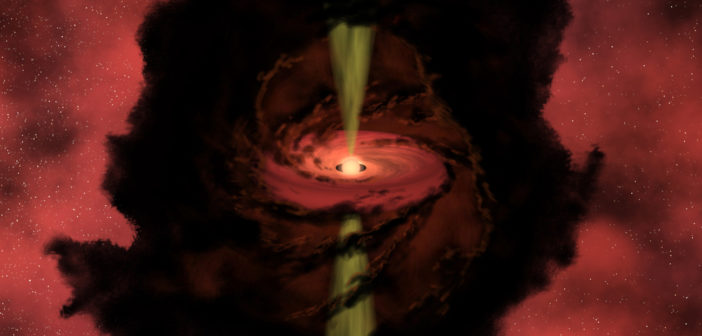Editor’s note: Astrobites is a graduate-student-run organization that digests astrophysical literature for undergraduate students. As part of the partnership between the AAS and astrobites, we occasionally repost astrobites content here at AAS Nova. We hope you enjoy this post from astrobites; the original can be viewed at astrobites.org.
Title: Zooming into the Collimation Zone in a Massive Protostellar Jet
Authors: Carlos Carrasco-González et al.
First Author’s Institution: UNAM: Radio Astronomy and Astrophysics Institute (IRyA-UNAM), Mexico
Status: Published in ApJL

This Hubble image reveals N159, a nursery for massive star formation within one of the Milky Way’s satellite galaxies, the Large Magellanic Cloud (LMC). [ESA/Hubble & NASA]
Low Mass vs. High Mass Jets
Studying the origin of protostellar jets is really tricky. These jets travel enormous distances and can affect their surroundings up to parsecs away, but if we want to understand the physics driving them, we must carefully observe the region where they originate, in close proximity to their parent protostar. Unfortunately, even with the most powerful radio telescopes, we can’t observe down to those kinds of physical scales for all but a handful of nearby star-forming regions. Recent high-resolution surveys of star-forming regions have revealed many of the details of protostellar outflows around the precursors of lower-mass stars (M < 8 solar masses or so), as described in this recent bite. More massive O and B type stars, however, are considerably more rare — which means there are very few examples of massive protostars nearby. The further away the protostar is, the better the angular resolution required to resolve the fine details that tell us how these jets are launched.
However, the outflows from massive (O/B type) protostars are thought to be notably different from the winds from their low-mass counterparts. It seems the the outflows from massive protostars are commonly less beam-like, (or collimated) and it is thought that they might have an entirely different physical mechanism responsible for the large-scale parallel structure of their jets. Instead of the protostar’s local magnetic field being responsible for the beam-like linearity of the outflow, it’s possible that massive stars eject mass wildly in nearly all directions, and the ambient magnetic fields of the protostar’s surroundings are responsible for collimating the beam. It’s impossible to determine the truth of the matter without high-resolution observations of the immediate surroundings of massive protostars.

Figure 1: The authors’ modeling of the innermost hundred au of the massive protostellar jet Cepheus A HW2. Upper left: the VLA radio image of the protostellar jet. The right three panels show the piecewise construction of the outflow model for a collimated jet, a conical wind, and the combination of both. The bottom left panel shows the model adjusted to fit the outflow angles and mass-loss rates of the observed source. [Carrasco-González et al. 2021]
The Closest Look Yet…

Figure 2: A comparison of the VLA image of Cepheus A HW2 (upper) with a cartoon schematic showing how a disordered distribution of protostellar winds might be collimated into a beam-like jet of outflowing mass. [Carrasco-González et al. 2021]
The authors suggest a couple interpretations for this fascinating system. Firstly, it’s possible that the same physics is responsible for launching highly collimated jets for both high- and low-mass stars, but the high-mass stars tend to become collimated further away from the protostar. Secondly, it might be that the high-mass protostars produce more disordered winds on their own, blowing away mass in wide cones or even spherically, and the magnetic ambient environment is responsible for turning the cone-like winds into a nice beam-like jet. Since so many massive protostars seem to have disordered outflows, it might be that a particularly opportune magnetic field structure in the surrounding cloud is needed to produce collimated jets so commonly seen for their low-mass protostars. While this is only one example of such an outflow, it brings us one big step closer to understanding the mysterious and elusive jets from massive protostars.
Original astrobite edited by Mitchell Cavanagh.
About the author, H Perry Hatchfield:
I’m a PhD candidate in Physics at the University of Connecticut, where I study star formation and gas structure in the Milky Way’s Galactic Center. I do this using radio observations of molecular clouds as well as hydrodynamic simulations, and I’m all about trying to find ways to compare these two exciting means of exploring the universe.
